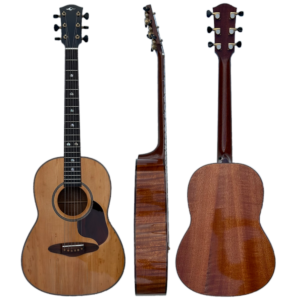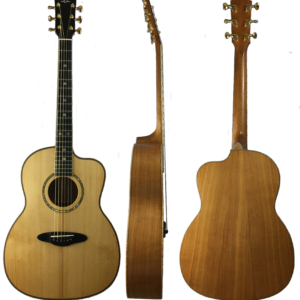Parlor guitar shootout part 1 includes an Art Davis T1MA and a Martin 2-17-25. The T1MA is made with merenti (Philippine mahogany) and a distressed Adirondack spruce top. The little 90 year old Martin is all mahogany. Both have mahogany necks.
Are you looking for a good parlor guitar?
Start here…
Traditionally, our knowledge of steel string parlors starts with companies such as Martin, Washburn, Gibson. Interestingly, they weren’t considered as parlor guitars. They were just guitars. Guitars got bigger when they had to compete in bands and orchestras. The first steel string guitars were diminutive and had nickel-steel strings. Bronze strings existed but they weren’t popular as they are today. Currently, some studio musicians are using nickel steel on acoustics for the honest sound they provide. Likewise, smaller well made guitars usually have less annoying habits for studio engineers to mitigate.
I like to visit a time when guitars were truly mobile. The light construction made them easier to carry. Additionally, a lighter guitar is less likely to be damaged in a fall. Furthermore, lightness gives the player better leverage. In other words, it is easier to make music on a lighter guitar. Truly, smaller guitars have more advantages.
Save the planet: Buy smaller guitars!
Economy and ecology also play a big part in modern guitar making. Smaller guitars use less wood. This is better for your wallet and better for our forests. Most importantly, you are more likely to score awesome tone wood for a guitar if you don’t have to get as much of it. Conversely, inexpensive wood was used to make both guitars in this video.
Obviously, big guitars can do things that small guitars can’t. However, if a big guitar wants to come to the parlor guitar shootout, I am game to try it. Otherwise, I’m betting you will be impressed with the sound that comes out of these two…




